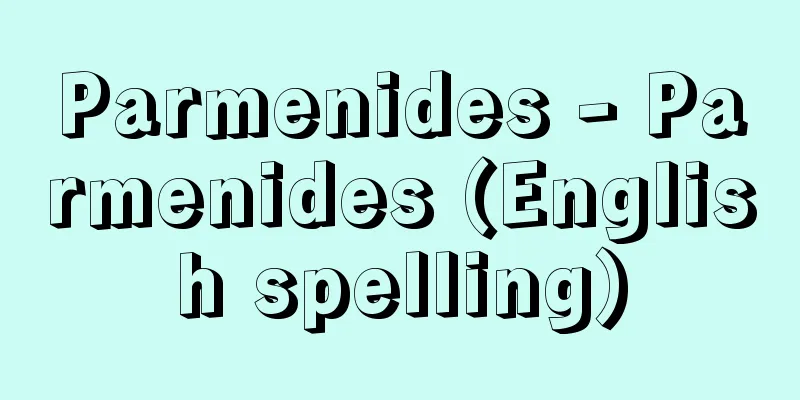Parmenides - Parmenides (English spelling)

|
Ancient Greek philosopher. Born in the town of Elea in southern Italy. Founder of the Elea School. Born into a wealthy and distinguished family, he was one of the town's leaders, and is said to have enacted laws for the citizens of Elea. He wrote the Peri-Physeos (On Nature) using hexagram, the meter of epic poetry, but only fragments remain today. This work consists of three parts: a prologue, a first part, and a second part. The prologue sets an allegorical stage in which the young Parmenides rides in a chariot driven by the daughters of the sun god, leaves the dark world of fear, and arrives in the bright world of truth, where he receives a revelation about truth and fear from the goddess. The first part sings of revealed truth, and based on the premise that there is "what is" (To-Eon) and there is no "what is not" (To-Me-Eon), it draws out the attributes of "what is" such as being immortal, indivisible, unchanging and immovable, and resembling a complete round sphere, and teaches that only reason, which shows us "what is," can grasp the truth, and that the senses, which lead us to believe in "multiplicity," creation, destruction and change, are the source of error. The second part sings of erroneous prejudice, and teaches that the world of the senses is created by juxtaposing two "forms" (Demas), "what is" (light) and "what is not" (darkness), and synthesizing everything from the two. The impact of these thoughts on the intellectual world of the time is immeasurable. [Mikiya Suzuki January 20, 2015] "Parmenides, translated by Norio Fujisawa (included in World Literature Series 63: Greek Thinkers, 1965, Chikuma Shobo)" [Reference item] |Source: Shogakukan Encyclopedia Nipponica About Encyclopedia Nipponica Information | Legend |
|
古代ギリシアの哲学者。南イタリアの町エレアに生まれる。エレア学派の始祖。富裕な名門の出身で、町の指導者の一人であったらしく、エレア市民のために法律を制定したとも伝えられる。叙事詩の韻律である六脚韻を駆使して『ペリ・フュセオース』(自然について)を書きつづったが、いまは断片が残されているのみである。この著作は、序詩、第一部、第二部といった三部からなっている。序詩は、若いパルメニデスが日の神の娘たちの駆る馬車に乗り、暗い臆見(おくけん)の世界を去って明るい真理の世界へたどり着き、女神から真理と臆見について啓示を受ける、といった寓話(ぐうわ)的な舞台を設定する。第一部は、啓示された真理を歌い、「在るもの」(ト・エオン)があり「在らぬもの」(ト・メー・エオン)はないという前提から、不生不滅、不可分、不変不動であって、完結した丸い球に似ている、といった「在るもの」の属性を引き出し、「在るもの」をわれわれに示す理性のみが真理をとらえ、「多」や生成や消滅や変化を信じさせる感覚は誤謬(ごびゅう)の源であると説く。第二部は、誤謬に満ちた臆見を歌い、感覚の世界は「在るもの」(光)と「在らぬもの」(闇(やみ))という二つの「形体」(デマス)を併置し、両者からあらゆるものを合成するところに生じると説く。こうした思索が当時の思想界に与えた影響は計り知れない。 [鈴木幹也 2015年1月20日] 『藤沢令夫訳『パルメニデス』(『世界文学大系63 ギリシア思想家集』所収・1965・筑摩書房)』 [参照項目] |出典 小学館 日本大百科全書(ニッポニカ)日本大百科全書(ニッポニカ)について 情報 | 凡例 |
<<: Barmen Declaration - Barmen theologische Erklärung
>>: Parmenion (English spelling)
Recommend
Hosso sect
This is a Buddhist school that was founded in the...
Flower Market
Flowers generally refer to flowering herbs, but wh...
Food coloring - food coloring
A food additive. A coloring agent used to color fo...
Concerto grosso - Gasso Kyousokyoyoku
An instrumental form established during the Baroqu...
Scotland - Scotland
It is one of the United Kingdoms that make up the...
Honda Tadakatsu
Year of death: October 18, 1610 (December 3, 1610)...
Permitted water rights - Permitted water rights
…In actuality, it refers to the right to continuo...
Chemical burn
What is the disease? This is a skin disorder caus...
Fangshan Yonggu Mausoleum (English: Fangshan Yonggu Mausoleum)
An ancient tomb from the Northern Wei period locat...
Pöppelmann, MD
…It was built in 1711-28. The architect was Matth...
WDHA syndrome
The main symptoms of this disease are watery diarr...
dura mater (English spelling) duramater
…the meninges encephali and the spinal cord menin...
Uthman (English spelling)
[Born] 574, Mecca [Died] June 656. The third calip...
Redhead - Akage
〘 noun 〙① Reddish hair. [Waei Rinshusei (reprint) ...
Gotoke Reijo - Gotoke Reijo
A collection of laws from the mid-modern period. A...









